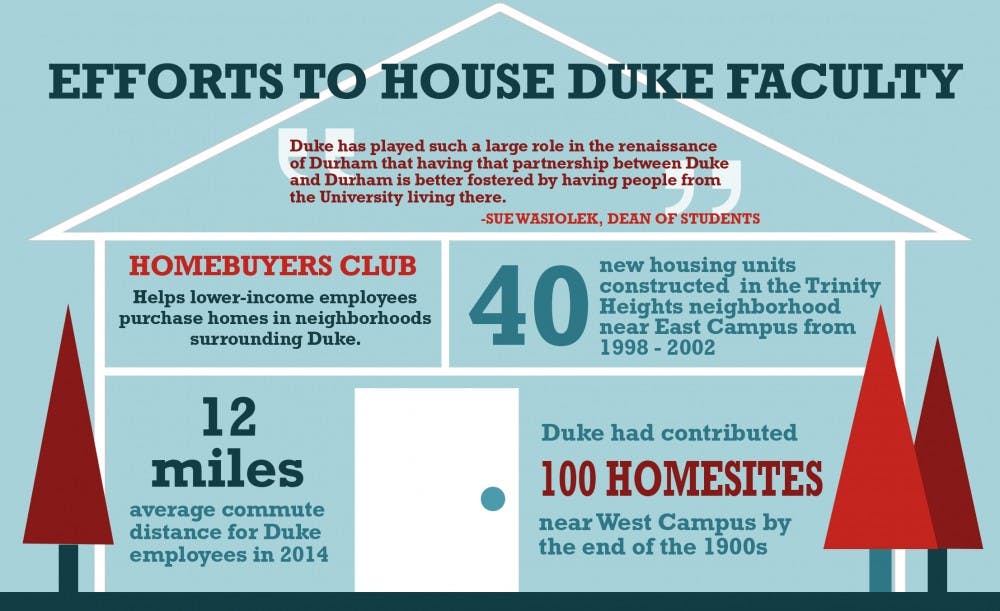President Richard Brodhead and Dean Sue Wasiolek might live on campus, but other faculty or staff live more than 50 miles away.
Since the 1930s, Duke has worked to help faculty and staff find homes close to the University, often by buying tracts of land and developing houses later sold to Duke employees. Examples include the “Duke Homesites,” which are houses in the Duke Forest built by the University, as well as 40 housing units developed in the Trinity Heights neighborhood near East Campus—a program that began in 1998 and ended in 2002. Currently, the University sponsors a Homebuyers Club designed to help lower-income Duke employees find homes.
“Duke has played such a large role in the renaissance of Durham that having that partnership between Duke and Durham is better fostered by having people from the University living there,” said Wasiolek, a prior resident of the Duke Homesites.
In the early 1900s, it would have been difficult for the University to convince new talent from other prestigious universities to live in Durham, said Jeffrey Potter, director of real estate administration. To correct this, Duke began buying land near West Campus and selling it to employees, allowing them to pay it off over time like a student loan, he explained.
By the end of the 1980s, Potter said, Duke had contributed to more than 100 different Homesites on streets just off of West Campus, such as Pinecrest Road, Cranford Road and Wrightwood Avenue, among others.
The program ended around 1990 as demand picked up, and Duke was less able to purchase land at a reasonable price. Since then, Duke has stopped taking an active role in the Homesites, instead leaving them to be sold on the private market.
Although Duke no longer takes a hands-on approach to the Homesites, the effort continues to pay dividends for Duke employees. Wasiolek estimated that, when she lived there, her street was split about evenly between Duke staff and non-Duke-affiliated residents.
Walks in the Duke Forest, the convenience of being so close to Duke and the ability to invite students to one’s home are some of the benefits of living so close to the University, said Stephen Jaffe, Mary and James H. Semans professor of music composition.
Encouraging faculty to live near campus fits with Duke’s goal to reduce its carbon footprint, Transportation Demand Manager Allison Carpenter wrote in an email. Employees living 3.9 miles from campus produced only 1,872 metric tons of carbon dioxide for a 48-work week period—compared to the 16,944 tons produced by those living 35 miles from campus, she wrote.
The average commute distance for Duke employees in 2014 was 12 miles, Carpenter wrote, according to data from the 2014 annual employee commute survey.
Soon after Nan Keohane took over as University President in 1993, Duke began redeveloping the Trinity Heights neighborhood with the goal of creating an identity and forging a community near East Campus.
Between 1998 and 2002, Duke built 40 units of new housing—25 houses and 15 townhouses—and sold them to various Duke employees, Potter wrote in an email.
“It’s one of the few projects I’ve ever worked on that came out better than we imagined it,” he said. “We didn’t know if anyone would buy the houses and if they would stay pretty for the next 15 years, but whenever I go by there they look terrific.”
Duke employees living in those houses are bound by a restrictive covenant that requires them to sell their house to another Duke employee, if and when they sell it, Potter explained.
If an owner is unable to sell the house to a Duke employee after a year, the owner must offer the house to the University for repurchase but can sell it to an unaffiliated individual if the University chooses not to buy it back, according to the Trinity Heights new home covenant.
Homesites residents are not required to try and sell the house to a Duke employee, but they are required to offer it back to the University. In practice, however, Duke rarely buys the house back, Potter explained.
Duke does not currently have a program designed to encourage faculty and staff to live closer to the University, he said, in large part because the city of Durham has become a much more attractive destination for prospective homebuyers.
The University also offers a Homebuyers Club designed primarily to help lower-income employees unable to afford homes on their own get situated, said Director of Community Engagement Sam Miglarese.
The club initially stemmed from an arrangement between Duke and Durham to help with the redevelopment of the Southside neighborhood, but since its inception three years ago, it has helped seven individuals purchase homes in neighborhoods other than Southside.
Although Duke has three employees living in Southside, they did not go through the Homebuyers Club, which will yield its first-ever Southside resident in December.
“I think it’s important that, as we provide information about housing for our faculty, we keep in mind that it’s an important balance issue,” Miglarese said. “We have employees at the University who are struggling to seek out the American dream.”
The Chronicle spoke with Potter both by phone and by email.
Get The Chronicle straight to your inbox
Signup for our weekly newsletter. Cancel at any time.

